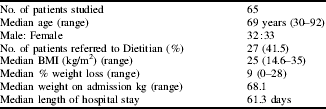The impact of Clostridium Difficile (C Diff) is widespread; ultimately impairing recovery and increasing length of hospital stay(1). The incidence of C Diff in Wales's averages 17 patients/1000 admissions; which is similar for Scotland and England. Risk factors for the development of C Diff are increasing age, poor general health, immuno-compromise and patients undergoing major surgery(1). The incidence in surgical patients equates to 9.6/1000 admissions(1). The risk of malnutrition both pre/post surgery is well documented(Reference Stroud2). However, the link between malnutrition and the subsequent development of C Diff in surgical patients is not widely published. It seems logical that the deleterious effects of malnutrition, both on immunological and gastrointestinal function(Reference Stroud2) may predispose patients to increasing risk of contracting C Diff. One of the recommendations of the recently published ‘Clostridium Difficile Infection – How to deal with the problem’ is that a Dietitian should form part of the multidisciplinary team reviewing all patients with C Diff.
The aim of this study was to review the current level of dietetic input to surgical patients who developed C Diff.
Data were collected retrospectively on confirmed cases of C Diff for 2008. The following data were collected, age, diagnosis, severity and duration of C diff, nutritional status (BMI, % weight loss and nutritional risk score), inflammatory markers, number of patients who were referred to the Dietitian, number of patients who received nutritional support and methods of delivering nutritional support and the duration and length of hospital stay.
During the study period 65 patients were confirmed with C Diff. The majority of patients were not referred to the Dietitian. The percentage weight loss on admission suggests that the cohort were malnourished. Of the patients referred to the Dietitian 61% required artificial nutritional support and 39% required sip feeds.

This review has concluded that patients confirmed with C Diff are often malnourished and the majority are not referred to the Dietitian. Further analysis of this dataset will be available late summer 2009.


